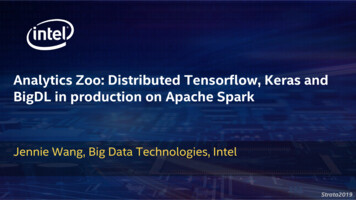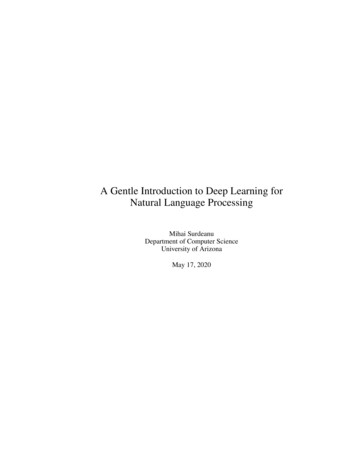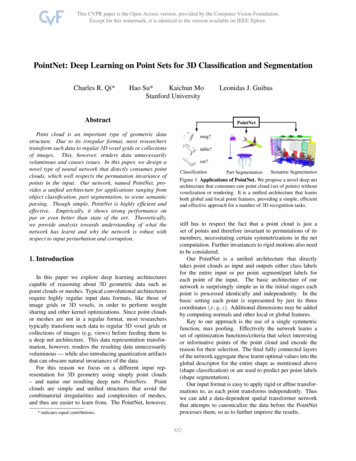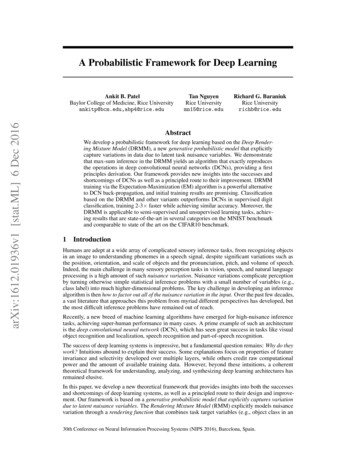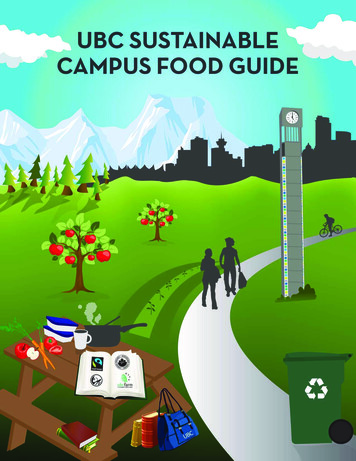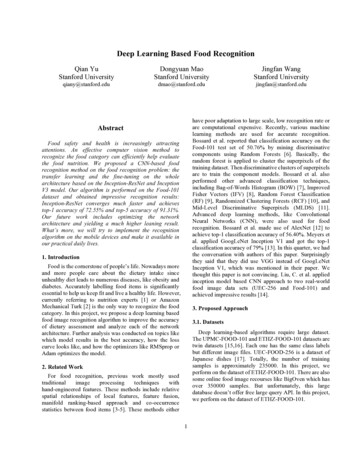
Transcription
Deep Learning Based Food RecognitionQian YuStanford UniversityDongyuan MaoStanford UniversityJingfan WangStanford an@stanford.eduhave poor adaptation to large scale, low recognition rate orare computational expensive. Recently, various machinelearning methods are used for accurate recognition.Bossard et al. reported that classification accuracy on theFood-101 test set of 50.76% by mining discriminativecomponents using Random Forests [6]. Basically, therandom forest is applied to cluster the superpixels of thetraining dataset. Then discriminative clusters of superpixelsare to train the component models. Bossard et al. alsoperformed other advanced classification techniques,including Bag-of-Words Histogram (BOW) [7], ImprovedFisher Vectors (IFV) [8], Random Forest Classification(RF) [9], Randomized Clustering Forests (RCF) [10], andMid-Level Discriminative Superpixels (MLDS) [11].Advanced deep learning methods, like ConvolutionalNeural Networks (CNN), were also used for foodrecognition. Bossard et al. made use of AlexNet [12] toachieve top-1 classification accuracy of 56.40%. Meyers etal. applied GoogLeNet Inception V1 and got the top-1classification accuracy of 79% [13]. In this quarter, we hadthe conversation with authors of this paper. Surprisinglythey said that they did use VGG instead of GoogLeNetInception V1, which was mentioned in their paper. Wethought this paper is not convincing. Liu, C. et al. appliedinception model based CNN approach to two real-worldfood image data sets (UEC-256 and Food-101) andachieved impressive results [14].AbstractFood safety and health is increasingly attractingattentions. An effective computer vision method torecognize the food category can efficiently help evaluatethe food nutrition. We proposed a CNN-based foodrecognition method on the food recognition problem: thetransfer learning and the fine-tuning on the wholearchitecture based on the Inception-ResNet and InceptionV3 model. Our algorithm is performed on the Food-101dataset and obtained impressive recognition results:Inception-ResNet converges much faster and achievestop-1 accuracy of 72.55% and top-5 accuracy of 91.31%.Our future work includes optimizing the networkarchitecture and yielding a much higher leaning result.What’s more, we will try to implement the recognitionalgorithm on the mobile devices and make it available inour practical daily lives.1. IntroductionFood is the cornerstone of people’s life. Nowadays moreand more people care about the dietary intake sinceunhealthy diet leads to numerous diseases, like obesity anddiabetes. Accurately labelling food items is significantlyessential to help us keep fit and live a healthy life. However,currently referring to nutrition experts [1] or AmazonMechanical Turk [2] is the only way to recognize the foodcategory. In this project, we propose a deep learning basedfood image recognition algorithm to improve the accuracyof dietary assessment and analyze each of the networkarchitecture. Further analysis was conducted on topics likewhich model results in the best accuracy, how the losscurve looks like, and how the optimizers like RMSprop orAdam optimizes the model.3. Proposed Approach3.1. DatasetsDeep learning-based algorithms require large dataset.The UPMC-FOOD-101 and ETHZ-FOOD-101 datasets aretwin datasets [15,16]. Each one has the same class labelsbut different image files. UEC-FOOD-256 is a dataset ofJapanese dishes [17]. Totally, the number of trainingsamples is approximately 235000. In this project, weperform on the dataset of ETHZ-FOOD-101. There are alsosome online food image recourses like BigOven which hasover 350000 samples. But unfortunately, this largedatabase doesn’t offer free large query API. In this project,we perform on the dataset of ETHZ-FOOD-101.2. Related WorkFor food recognition, previous work mostly ngineered features. These methods include relativespatial relationships of local features, feature fusion,manifold ranking-based approach and co-occurrencestatistics between food items [3-5]. These methods either1
Table 1. Food DatasetsDataset# of dishclasses# of imagesper classDatatypeUPMC-FOOD-101101790-956Text mageFigure 1. Inception Structure3.2. Model3.3. Image PreprocessingCNN become increasingly powerful in large scale imagerecognition after Krizhevsky et al. won the first prize inILSVRC 2012 with the introduction of AlexNet [12].AlexNet has 60 million parameters and 650,000 neurons,consists of five convolutional layers. Those layers nnected layers with a final 1000-way softmaxlayer [12].After that, there are several symbolic milestones in thehistory of CNN development, which are ZFNet [18] byZeiler and Fergus, VGGNet [19] by Simonyan et al.,GoogLeNet (Inception-v1) [20] by Szegedy et al andResNet [21] by He et al.GoogLeNet or Inception V1 was the winner of ILSVRC2014. It largely reduced the ImageNet top-5 error from 16.4%which obtained by AlexNet to 6.7% [22]. The Inceptiondeep convolutional architecture was introduced, with theadvantages of less parameters (4M, compared to AlexNetwith 60M) [20]. Average Pooling instead of FullyConnected layers at the top of the ConvNet was applied toeliminate unnecessary parameters. Later, there are severalmore advanced versions to Inception V1. Batchnormalization was introduced in Inception V2 [23] byLoffe et al. Later the architecture was improved byadditional factorization ideas in the third iteration whichwill be referred to as Inception V3 [24]. Inception V4 has amore uniform simplified architecture and more inceptionmodules than Inception V3 [25]. Szegedy et al. designedInception-ResNet to make full use of residual connectionsintroduced by He et al. in [21] and the latest revised versionof the Inception architecture. Training with residualconnections accelerates the training of Inception networksby utilizing additive merging of signals [25].Tensorflow provides the API for loading andpreprocessing raw images from the user. However, in ourproject, we still need to preprocess the input images. This isbecause the environmental background varies quite a lot indifferent food pictures. Those environmental factors are thecolor temperatures, luminance and so on. To have similarbackground environment, we utilize two methods whichare Grey World method and Histogram equalization.The white balance is processed by the Grey WorldMethod which assumes the average of the RGB values areall similar to the one grey value. The Grey World algorithmis as followed, where α, β, γ are the scaling factors in theRGB color channels.αRαGαB(αR, βG, γB) (α,,γ)𝑅 β -𝐺𝐵𝑛𝑛𝑛Then, we applied Histogram Equalization algorithm toincrease the contrast and luminance. The imagepreprocessing result is shown as below. The first one is theimage of a baby rib. The middle one is the image after thewhite balance and the right one is the one after both whitebalance and histogram equalization.Figure 2. Image processing: (left) raw image, (middle) performGrey World method, (right) perform Histogram Equalization onthe middle image.Image preprocessing effectively handles the problemwhen the pictures were taken in different environmentbackground which speed up the learning pace and slightlyimprove the output accuracy. We will explore this more inthe result section.2
around 40% which is far from the result we expected. Tofix this problem, we try to train the whole layer instead ofonly training the last layer and obtain a much higheraccuracy. We will discuss this more in the result section.Thirdly, evaluate the result. At the first stage, we split thedatasets into training and evaluation parts. The trainingexamples take 80% of the whole datasets and the rest areconsidered as testing datasets. By running the evaluation onthe last layer of the network, we obtain the training andtesting error. We also evaluate the testing accuracy on thefull layer model as discussed above.Finally, fine tuning the network framework. We need togive the model initial parameters, and setup optimizationprocess. For example, weight decay prevents overfitting.By adjusting the weight decay, we can balance betweenvariance and bias. Also, optimizers like Adam andRMSprop need different initial parameters, such as learningrate and learning rate decay. To achieve the minimum loss,these parameters need be set carefully.The training process is mainly divided into 2 processes:last layer with 0.01 initial learning rate and 101 batch size,full network with 0.001 initial learning rate and 7 batch size.Within each process, we compare the different resultsbetween raw image input and processed image input. Also,we compare different network structures: Inception V3 andInception-ResNet.Figure 3: Images before preprocessingFigure 4: Images after preprocessing4. ResultThe results analysis will cover the following topics:optimizer selection, network analysis, model comparisons.3.4. MethodologyWe utilized the Amazon AWS GPU resources to run thewhole program. The AWS g2 instance has NVIDIA GRIDK340 with 1536 CUDA cores and 4GB memory size whichenables to run a complicated network structure. Theframework for deep learning is the latest slim version ofTensorflow. We applied the transfer learning method to ourmodel which is by using the pre-trained model as acheckpoint and continue to train the neural network. Thereason that we can do so is because the ImageNet has verylarge amount of dataset and is trained quite well. We canmake full use of the pre-trained model and get the featurebased on the ImageNet dataset.Firstly, use the pre-trained model of Inception V3 andInception-ResNet. We load a checkpoint from thepre-trained model, which is a file that stores all the tensorsafter weeks of training for the ImageNet datasets.Secondly, train the last layer of the network andrecognize classes of food images. As we know that the lastlayer for the ImageNet classifier is 2048*1001. However,in our problem, we only have 101 food classes. Therefore,in this case, the dimension for the last layer is 2048*101.We replace the final 1001-way softmax with a 101-waysoftmax. Then we retrain the last layer to get a model basedon the pre-trained model. However, we later find that thepure transfer learning can only obtain the testing accuracyFigure 5. Loss curve of each iteration step with differentoptimizers3
that RMSprop descends faster at the beginning, butfluctuates a lot. While Adam descends slower but steadier.Therefore, we choose RMSprop at the beginning for itsquicker convergence and Adam at the end for its stability.Also, the fluctuation in full network training is muchgreater than that in the last layer training. This is becausethe batch size of full network training is much smaller dueto limited GPU memory.4.2. Network analysisChoice of network models determines final predictionaccuracy after convergence of retraining. Here, we need topick models that can be smoothly adapted to foodrecognition. Fig. 6&7 compares two best models onImageNet – Inception V3 and Inception-ResNet.Firstly, we only retrain the last layer (softmax layer) ofthe model. This means that the features extracted fromImageNet can be generalized to food recognition. Thefigures show that Inception-ResNet preforms better afterconvergence of the last layer retraining, meaning that thefeatures extracted by Inception-ResNet is more generalthan those by Inception V3. Also, the comparison betweenraw image input and processed image input shows thatpreprocessing has no improvement on recognition, becausethe former layers of those models have already learned topreprocess image.Secondly, we retrain the model on all layers. The Figuresshow that retraining on full network gains a largeimprovement on retraining only on the softmax layer. Thissuggests that the features extracted from ImageNet are notsuitable for food recognition. Also, this time, preprocessedinput has roughly 3% accuracy advantage to raw input. Thisis because certain neurons that are used for preprocessingare freed to extract additional features of food, whichresults in a better prediction. Additionally, on full networktraining, Inception V3 performs roughly the same asInception-ResNet. This suggests that these two modelshave the same learning ability, but features ofInception-ResNet are more extensible. Lastly, overfittingoccurs only when accuracy rise above 60%, and we gotfinal overfitting of 3%.Figure 6. Results of Inception V3: Accuracy of each epochFigure 7. Results of Inception-ResNet: Accuracy of each epoch4.1. Optimizer selectionsChoice of optimizers greatly affect on loss descendingprocess. This is the first thing we need to decide to achievethe global minimum. We compare two mostly usedoptimizers to see their performance. The first one isRMSprop, which is proposed to solve the prematureconvergence of Adagrad [26]. For each step, RMSpropdivides the learning rate by average momentum of squaredgradients and a constant, which prevents prematurediminishing of learning rate. The second one is Adam,which reduces the loss fluctuation of RMSprop byintroducing additional average momentum of gradientsaverage [26]. It replaces the gradients with gradientsaverage in the update of theta, which makes its loss descendmore smoothly than that of RMSprop in stochastic gradientdescent. Fig.5 compares these built-in optimizers under thelast layer training and full network training. It can be seen4.3. Model comparisonsTable 2. Accuracy comparison (on Food-101 rds Histogram [6]28.51%NARandomized Clustering Forests [6]28.46%NARandom Forest Classification [6]32.72%NAImproved Fisher Vectors [6]38.88%NA
MethodTop-1AccuracyTop-5AccuracyDiscriminative Componentswith Random Forests [6]50.76%NAMid-Level Discriminative Superpixels [6]42.63%NAAlexNet [6]56.40%NAGoogLeNet (10,000 iterations) [14]70.2%91.0%GoogLeNet (300,000 iterations) [14]77.4%93.7%Inception V3 (last layer training)35.32%62.97%Inception-ResNet (last layer training)42.69%72.78%Inception V3 (full layer training)70.60%90.91%Inception-ResNet (full layer training)72.55%91.31%also implement the fine-tuning on the weights of thepre-trained network by continuing the backpropagation.There are two important factors. One is the size of newdataset. Food 101 consists of 101*1000 images, which islarge enough for CNN. The other one is that ImageNet-likein terms of the content of images and the classes. Theimages in Food-101 have great similarity to ImageNet.As we can see from Table 2, Inception and ResNet modelboth output very nice recognition accuracy. This is becauseboth models have very deep network structures. When theparameters are all fit on the training set, the network canmake very accurate generalization on the testing set.However, since ResNet has the residual structure whichadds the forward propagation in the network, the ResNetcan accelerate the learning speed and result in much lessinformation loss in the network iterations.5. Conclusion and Future WorkIn conclusion, fine-tuning on all the layers significantlyincrease the recognition accuracy with updated weights. Inaddition, Inception-ResNet outputs better recognitionaccuracy than the Inception-V3 because of the residualstructure.Here are something that we can explore more on thisfood recognition problem. The time we choose to evaluatethe training and testing accuracy is after processing thewhole training dataset. However, it may not be the timewhen we reach the lowest loss, instead, it is a lower boundof the evaluating accuracy. Therefore, the result we gotwhen using the Inception-ResNet is possibly not the bestresult we could get from the current model. To get a betterresult, we can set up a loss threshold for doing theevaluation. We expect a higher training and testingaccuracy but we will probably encounter an overfittingproblem. The second thing we can do is to do slightmodification to the ResNet and train the whole network ona powerful GPU instead of using the pre-trained modelbased on the ImageNet challenge. However, this may takequite long time to do because Food-101 is a large datasetand require weeks of training time. But we may get a betterresult since we can find the best network structure andparameters that fits the problem well. In the previous work,Liu, C. et al. has done the bounding box which did imagesegmentation first and then do the classification. Thiswould effectively increase the testing accuracy since wecan eliminate other non-related objects and keep the mainpart of the food. This requires manual cropping orautomatic segmentation which makes the model even morecomplicated and will give a much better result. Extractingfeatures in the last layer is a very common way to visualizethe main feature component in each class and will give usvery straightforward sense of why the CNN can understandeach dish.From Table 2, Inception V3 and Inception-ResNettraining on full layers outperforms other methods exceptGoogLeNet. Compard with other CNN architecture,AlexNet is the first architecture, which makes CNNpopular. AlexNet is a 7-layer model, consisting 5convolutional layers and 2 fully-connected layers. It wasthe winner of ImageNet ILSVRC challenge in 2012 withtop-5 error of 16.4%, while Inception V1 reduced the top-5error to 6.7%.The main reason why our methods perform better isbecause the inception module (Figure 1) increases therepresentation power of neural network. The input is fedinto an additional 1*1 convolutional layer instead offeeding into 3*3 and 5*5 convolutional layer to reduce theinput dimension. Moreover, after the 3*3 max-poolinglayer, the output is fed into an additional 1*1 convolutionallayer, resulting in deeper depth and less dimensions.Multiple modules are used to form the GoogLeNet, makingthe network hierarchical step by step. Overall, the featuremapping contains much more information than before.From Table 2, after 300,000 iterations, the deep learningmethod developed by Liu, C. et al. has better top-1accuracy and top-5 accuracy than us. Actually, Liu, C. et al.also applied transfer learning and had very similararchitecture of GoogLeNet with us. Then main reason whytheir results are better is that they have more iterations. Liu,C. et al. also reported that after 10,000 iteration steps, thetop-1 accuracy is 70.2% and top-5 accuracy is 91.0%,which means our results are competitive since we onlyiterate 12,000 steps due to the limit of the computationresources. If we perform more iterations, our methods mayhave similar performance.Overall transfer learning method results in goodaccuracy for food recognition. The ConvNet pre-trained onImageNet is a good feature extractor for a new dataset. We5
Referencesconvolutions. In Proceedings of the IEEE Conference onComputer Vision and Pattern Recognition (pp. 1-9).[21] He, K., Zhang, X., Ren, S., & Sun, J. (2015). Deep residuallearning for image recognition. arXiv preprint arXiv:1512.03385.[22] Convolutional Neural Networks (CNNs / tworks/[23] Ioffe, S., & Szegedy, C. (2015). Batch normalization:Accelerating deep network training by reducing internal covariateshift. arXiv preprint arXiv:1502.03167.[24] Szegedy, C., Vanhoucke, V., Ioffe, S., Shlens, J., & Wojna, Z.(2015). Rethinking the inception architecture for computer vision.arXiv preprint arXiv:1512.00567.[25] Szegedy, C., Ioffe, S., & Vanhoucke, V. (2016). Inception-v4,inception-ResNet and the impact of residual connections onlearning. arXiv preprint arXiv:1602.07261.[26] An overview of gradient descent optimization adient-descent/[1] Martin, C., Correa, J., Han, H., Allen, H., Rood, J.,Champagne, C., Gunturk, B., Bray, G.: Validity of the remotefood photography method (RFPM) for estimating energy andnutrient intake in near real-time. Obesity (2011)[2] Noronha, J., Hysen, E., Zhang, H., Gajos, K.Z.: Platemate:crowdsourcing nutritional analysis from food photographs. In:ACM Symposium on UI Software and Technology (2011)[3] S. Yang, M. Chen, D. Pomerleau, and R. Sukthankar, "Foodrecognition using statistics of pairwise local features," inComputer Vision and Pattern Recognition (CVPR), 2010 IEEEConference on, 2010.[4] Y. Matsuda and K. Yanai, "Multiple-food recognitionconsidering co-occurrence employing manifold ranking," inPattern Recognition (ICPR), 2012 21st International Conferenceon, 2012.[5] TADA: Technology Assisted Dietary Assessment at PurdueUniversity, West Lafayette, Indiana, USA, available athttp://www.tadaproject.org/.[6] Bossard, L., Guillaumin, M., & Van Gool, L. (2014,September). Food-101–mining discriminative components withrandom forests. In European Conference on Computer Vision (pp.446-461). Springer International Publishing.[7] Lazebnik, S., Schmid, C., Ponce, J.: Beyond bags of features:Spatial pyramid matching for recognizing natural scene categories.In: CVPR (2006)[8] S ́anchez, J., Perronnin, F., Mensink, T., Verbeek, J.: ImageClassification with the Fisher Vector: Theory and Practice. IJCV(2013)[9] Bosch, A., Zisserman, A., Munoz, X.: Image Classificationusing Random Forests and Ferns. In: ICCV (2007)[10] Moosmann, F., Nowak, E., Jurie, F.: Randomized clusteringforests for image classification. PAMI (2008)[11] Singh, S., Gupta, A., Efros, A.A.: Unsupervised discovery ofmid-level discriminative patches. In: ECCV (2012)[12] Krizhevsky, A., Sutskever, I., Hinton, G.E.: Imagenetclassification with deep convolutional neural networks. In: NIPS(2012)[13] Meyers, A., Johnston, N., Rathod, V., Korattikara, A.,Gorban, A., Silberman, N., . & Murphy, K. P. (2015).Im2Calories: towards an automated mobile vision food diary. InProceedings of the IEEE International Conference on ComputerVision (pp. 1233-1241).[14] Liu, C., Cao, Y., Luo, Y., Chen, G., Vokkarane, V., & Ma, Y.(2016, May). DeepFood: Deep Learning-Based Food ImageRecognition for Computer-Aided Dietary Assessment.In International Conference on Smart Homes and HealthTelematics (pp. 37-48). Springer International Publishing.[15] UPMC-FOOD-101, http://webia.lip6.fr/ wangxin/[16] ts extra/food-101/[17] UEC-FOOD-256, http://foodcam.mobi/dataset256.html[18] Zeiler, M. D., & Fergus, R. (2014, September). Visualizingand understanding convolutional networks. In EuropeanConference on Computer Vision (pp. 818-833). SpringerInternational Publishing.[19] Simonyan, K., & Zisserman, A. (2014). Very deepconvolutional networks for large-scale image recognition. arXivpreprint arXiv:1409.1556.[20] Szegedy, C., Liu, W., Jia, Y., Sermanet, P., Reed, S.,Anguelov, D., . & Rabinovich, A. (2015). Going deeper with6
inception model based CNN approach to two real-world food image data sets (UEC-256 and Food-101) and achieved impressive results [14]. 3. Proposed Approach 3.1. Datasets Deep learning-based algorithms require large dataset. The UPMC-FOOD-101 and ETHZ-FOOD-101 datasets are

